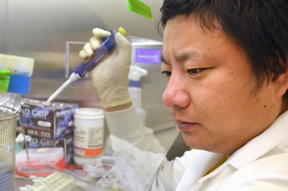Home > Press > Silver nanoparticle concentration too low to be harmful in water supply, paper finds
 |
| Chiqian Zhang and his team analyzed the results of approximately 300 published works on the subject of silver nanoparticles and wastewater. CREDIT: MU College of Engineering |
Abstract:
Silver nanoparticles have a wide array of uses, one of which is to treat drinking water for harmful bacteria and viruses. But do silver nanoparticles also kill off potentially beneficial bacteria or cause other harmful effects to water-based ecosystems? A new paper from a team of University of Missouri College of Engineering researchers says that's not the case.
Silver nanoparticle concentration too low to be harmful in water supply, paper finds
Columbia, MO | Posted on October 14th, 2016In their paper, "Governing factors affecting the impacts of silver nanoparticles on wastewater treatment," recently published in Science of the Total Environment, Civil and Environmental Engineering Department doctoral students Chiqian Zhang and Shashikanth Gajaraj and Department Chair and Professor Zhiqiang Hu worked with Ping Li of the South China University of Technology to analyze the results of approximately 300 published works on the subject of silver nanoparticles and wastewater. What they found was while silver nanoparticles can have moderately or even significantly adverse effects in large concentrations, the amount of silver nanoparticles found in our wastewater at present isn't harmful to humans or the ecosystem as a whole.
"If the concentration remains low, it's not a serious problem," Zhang said.
Silver nanoparticles are used in wastewater treatment and found increasingly in everyday products in order to combat bacteria. In terms of wastewater treatment, silver nanoparticles frequently react with sulfides in biosolids, vastly limiting their toxicity.
Zhang said many of the studies looked at high concentrations and added that if, over time, the concentration rose to much higher levels of several milligrams per liter or higher), toxicity could become a problem. But he explained that it would take decades or even longer potentially to get to that point.
"People evaluate the toxicity in a small-scale system," he said. "But with water collection systems, much of the silver nanoparticles become silver sulfide and not be harmful."
####
For more information, please click here
Contacts:
Jeff Sossamon
573-882-3346
Copyright © University of Missouri-Columbia
If you have a comment, please Contact us.Issuers of news releases, not 7th Wave, Inc. or Nanotechnology Now, are solely responsible for the accuracy of the content.
| Related News Press |
News and information
![]() Researchers develop molecular qubits that communicate at telecom frequencies October 3rd, 2025
Researchers develop molecular qubits that communicate at telecom frequencies October 3rd, 2025
![]() Next-generation quantum communication October 3rd, 2025
Next-generation quantum communication October 3rd, 2025
![]() "Nanoreactor" cage uses visible light for catalytic and ultra-selective cross-cycloadditions October 3rd, 2025
"Nanoreactor" cage uses visible light for catalytic and ultra-selective cross-cycloadditions October 3rd, 2025
Govt.-Legislation/Regulation/Funding/Policy
![]() New imaging approach transforms study of bacterial biofilms August 8th, 2025
New imaging approach transforms study of bacterial biofilms August 8th, 2025
![]() Electrifying results shed light on graphene foam as a potential material for lab grown cartilage June 6th, 2025
Electrifying results shed light on graphene foam as a potential material for lab grown cartilage June 6th, 2025
![]() Institute for Nanoscience hosts annual proposal planning meeting May 16th, 2025
Institute for Nanoscience hosts annual proposal planning meeting May 16th, 2025
Discoveries
![]() Researchers develop molecular qubits that communicate at telecom frequencies October 3rd, 2025
Researchers develop molecular qubits that communicate at telecom frequencies October 3rd, 2025
![]() Next-generation quantum communication October 3rd, 2025
Next-generation quantum communication October 3rd, 2025
![]() "Nanoreactor" cage uses visible light for catalytic and ultra-selective cross-cycloadditions October 3rd, 2025
"Nanoreactor" cage uses visible light for catalytic and ultra-selective cross-cycloadditions October 3rd, 2025
Announcements
![]() Rice membrane extracts lithium from brines with greater speed, less waste October 3rd, 2025
Rice membrane extracts lithium from brines with greater speed, less waste October 3rd, 2025
![]() Researchers develop molecular qubits that communicate at telecom frequencies October 3rd, 2025
Researchers develop molecular qubits that communicate at telecom frequencies October 3rd, 2025
![]() Next-generation quantum communication October 3rd, 2025
Next-generation quantum communication October 3rd, 2025
![]() "Nanoreactor" cage uses visible light for catalytic and ultra-selective cross-cycloadditions October 3rd, 2025
"Nanoreactor" cage uses visible light for catalytic and ultra-selective cross-cycloadditions October 3rd, 2025
Interviews/Book Reviews/Essays/Reports/Podcasts/Journals/White papers/Posters
![]() Spinel-type sulfide semiconductors to operate the next-generation LEDs and solar cells For solar-cell absorbers and green-LED source October 3rd, 2025
Spinel-type sulfide semiconductors to operate the next-generation LEDs and solar cells For solar-cell absorbers and green-LED source October 3rd, 2025
![]() Rice membrane extracts lithium from brines with greater speed, less waste October 3rd, 2025
Rice membrane extracts lithium from brines with greater speed, less waste October 3rd, 2025
Environment
![]() Researchers unveil a groundbreaking clay-based solution to capture carbon dioxide and combat climate change June 6th, 2025
Researchers unveil a groundbreaking clay-based solution to capture carbon dioxide and combat climate change June 6th, 2025
![]() Onion-like nanoparticles found in aircraft exhaust May 14th, 2025
Onion-like nanoparticles found in aircraft exhaust May 14th, 2025
![]() SMART researchers pioneer first-of-its-kind nanosensor for real-time iron detection in plants February 28th, 2025
SMART researchers pioneer first-of-its-kind nanosensor for real-time iron detection in plants February 28th, 2025
Safety-Nanoparticles/Risk management
![]() Onion-like nanoparticles found in aircraft exhaust May 14th, 2025
Onion-like nanoparticles found in aircraft exhaust May 14th, 2025
![]() Closing the gaps — MXene-coating filters can enhance performance and reusability February 28th, 2025
Closing the gaps — MXene-coating filters can enhance performance and reusability February 28th, 2025
|
|
||
|
|
||
| The latest news from around the world, FREE | ||
|
|
||
|
|
||
| Premium Products | ||
|
|
||
|
Only the news you want to read!
Learn More |
||
|
|
||
|
Full-service, expert consulting
Learn More |
||
|
|
||








